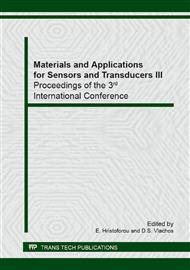p.457
p.461
p.465
p.470
p.474
p.478
p.483
p.487
p.491
Stretchable and Wearable Piezoresistive Insole for Continuous Pressure Monitoring
Abstract:
The feedback in the motor relearning therapy is essential and helpful for hemiplegic patient training. Tracking plantar pressure is clinically imperative to evaluate the foot function and in particular to assist patients with musculoskeletal and neurological diseases in the development of normal gait functionality. A flexible piezoresistive insole with dedicated electronics was developed to measure both the pressure distribution under 64 nodes arranged in the main plantar regions and the mean plantar pressure during walking activity with a sampling frequency of 20 Hz. This study reports on the easy and cost effective approach used to fabricate the flexible insole based on a piezoresistive material composed by copper spiky microparticles dispersed into silicon rubber. The entire insole was fabricated by single step casting technique, and then completed with a patterned metalized polyimide films as bottom electrode, while the top electrode was directly sputtered on the sample.
Info:
Periodical:
Pages:
474-477
Citation:
Online since:
April 2014
Price:
Сopyright:
© 2014 Trans Tech Publications Ltd. All Rights Reserved
Share:
Citation:


